Use household items to visualise and explain why we see the moon as different shapes.
What you need:
- a light/torch
- a ball
- a smaller ball
- aluminium foil (optional)
- stick or string (optional)
What to do:
- Cover the smaller ball in aluminium foil and put it on a string or stick (optional) – this is your moon.
- Turn the light on – this is your sun.
- Place the larger ball near the light – this is the Earth.
- Put the smaller ball – the “moon” in between the light and the sun. Observe where the light hits. Observe which part you can see from the “Earth”.
- Move the “moon” around the “Earth”, noticing how much of the lit section you can see from the “Earth”.
- Put the moon behind the Earth, but make sure the sun is still shining on it. Observe how much of the lit surface of the moon you can see from the Earth.
- Try moving the moon across the front of the Earth so that a shadow is cast on the Earth – this is a solar eclipse.

